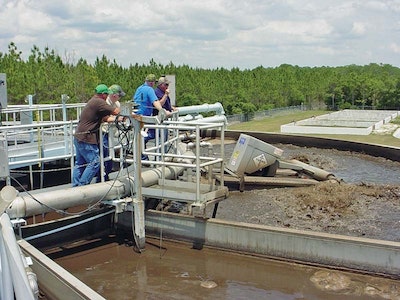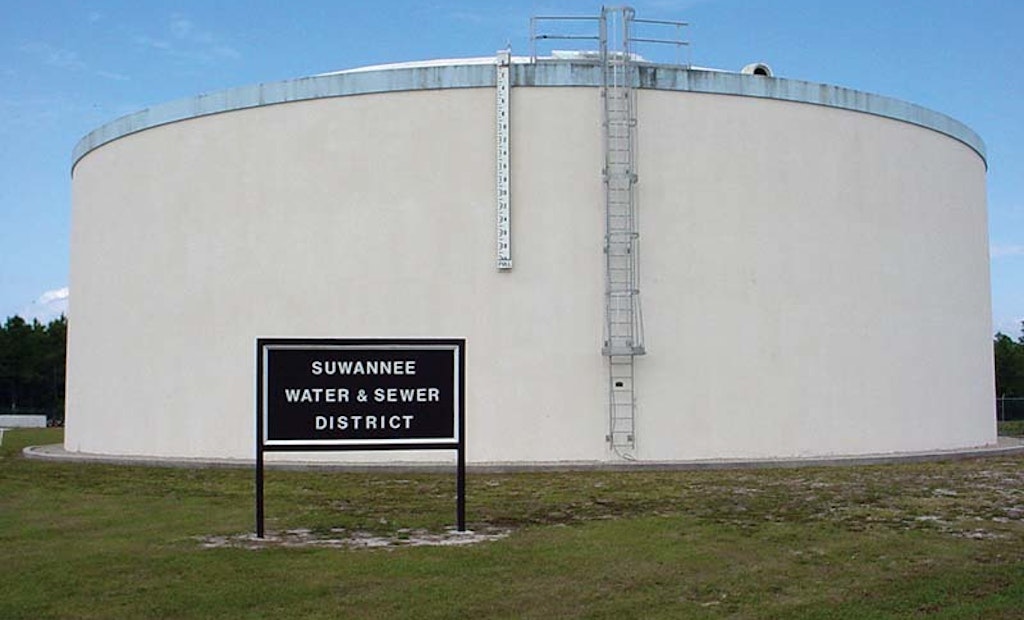Interested in Treatment?
Get Treatment articles, news and videos right in your inbox! Sign up now.
Treatment + Get AlertsChanges come slowly in the wastewater treatment industry. That’s why a recent process improvement at a Florida plant is gaining attention.
An air-infusion aerator installed in the aeration basin at the Suwannee Wastewater Treatment Plant has enabled high-capacity mixing and water movement, increased treatment efficiency, and boosted dissolved oxygen, while using significantly less energy.
The scenario began in 2015 when the Suwannee Water and Sewer District decided to completely renovate the 20-year-old plant and awarded the contract to Waterborne Madison, Florida.
Seeking innovation
“When this process began, Suwannee asked if we had any innovative ways to reduce their electric bill,” recalls Don Drummond, president of Waterborne and a veteran of some 40 years in the industry. “We had the idea to incorporate an aerator into the aeration basin. We believed it would improve process efficiency and effectiveness and do so while consuming less electricity.
“I had been working for over a year with Dean Caldwell, the president of Airmaster Aerators, and I became convinced that with their air-infusion aerators we could make a serious improvement to the process, even to the point of being a game-changer.”
The Suwannee team’s goals were challenging: reduce energy usage, increase mixing, raise DO levels, remove sludge, reduce odors, and improve overall efficiency. Overhaul of the plant began in January 2016, affecting half of the plant at a time, so the other half could continue running.
Drummond worked with Bob Bogosta, district general manager, and Matt Frierson, chief operator. The overhaul took more than three months. After all the waterblasting, welding, re-piping and painting, it was time to add the aerator.
Aerating and mixing
“Our aerator, with infusion aeration technology, is designed with no spray holes and has a downdraft tube,” says Airmaster’s Caldwell. “In operation, wastewater is pulled up through the downdraft tube and into the aerator. The wastewater is then pressurized in the aerator discharge manifold, and air from the turbo blower is forced through the air manifold and into the discharge manifold.
“The air infusion tube is terminated on the outside of the discharge manifold. Inside the discharge manifold are a pair of vanes that make the wastewater spiral around the air infusion tube. When the oxygen generator tubes are bolted on the discharge manifold, this creates a negative pressure zone.
“At this point, the aerator disrupts the molecular structure of the wastewater and infuses air into it. The air-infused wastewater is then discharged from the right and left sides of the aerator and mixed from the top of the basin to the bottom. This creates a complete mix of air-infused wastewater in the basin without increasing its temperature.
We do this using less energy via a low-horsepower motor.”
Taking the leap
Although no one involved in the project had heard of using an aerator in this way, Drummond pushed for it to be a part of the permitting. “I had several people tell me flat out that it would not work — engineers, operators, biologists,” he says. “But I was thoroughly convinced that it would work.” The Florida Department of Environmental Protection authorized a pilot study after Drummond gave an in-depth description.
Ultimately, Suwannee received a permit to replace its existing air-bubble diffuser with the surface aeration system. On March 15, 2016, Drummond and his crew lifted the Airmaster Turbo Xtreme 25 hp aerator and gently set it into place in the center of the aeration basin of the refurbished treatment plant.
Before activating the aerator, Frierson let all the air out of the aeration basin and reduced the DO level to zero. He then turned the aerator on and let it start churning, mixing and aerating the water. After one hour, he took the DO readings at three places in the basin. The DO levels were 2 ppm higher than those achieved by the previous diffused aeration system and its 75 hp blower. Frierson then turned the aerator off, took readings in the same places at increments of 30 minutes, 45 minutes and one hour, and found similar DO level readings every time.
“Honestly, when they put it in, I didn’t think it was going to work,” he says. “Now that we’ve used it a while, it has cleaned everything up real well, and it puts a lot of air into the water. With that aerator, it mixes everything well, and it gets all that sludge up off the bottom, too.”
Getting validation
Bogosta observes, “The factors that interested me originally were the energy efficiency and the oxygen transfer. It’s still early, and we really want to see the results of this long term, but so far it is looking good. Also, with the aerator there is less maintenance than with blowers or diffusers. After three months, we saw over 30 percent savings in our electric consumption. We also received our new FDEP permit and the Airmaster system was approved.”
Wanting a third party to evaluate their findings, Drummond and Caldwell invited Jamie Hope, wastewater technician with the Florida Rural Water Association, to see the application.
“To my knowledge, an aerator has not been used in this type of application before,” Hope says. “It was enlightening. You could tell the oxygen was being transferred efficiently, and it was providing mixing as well as oxygen transfer. Looking at the lab numbers, you can see that it is much more efficient than the previous method.”
Drummond adds, “We are still treating wastewater biologically. The greater efficiency of this method, using contact with dissolved oxygen rather than diffused aeration, yields better treatment for high BOD or accidental shocks to the treatment plant.”
Caldwell concludes, “We think we can make the same impact as we did in Suwannee in wastewater treatment plants all across the country.”







